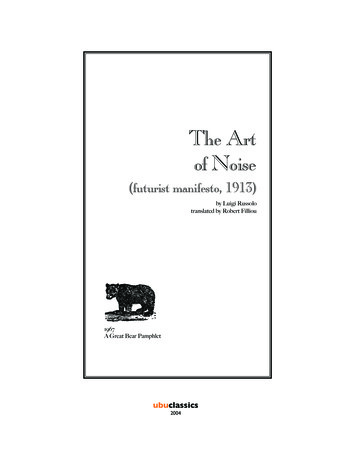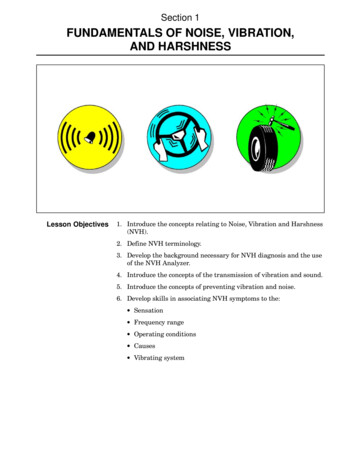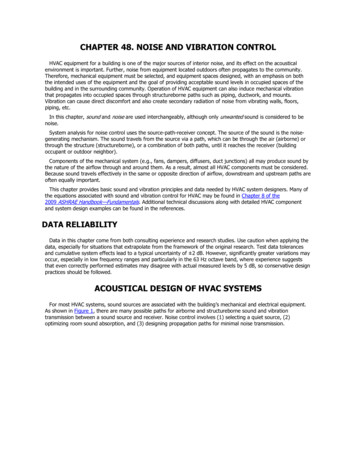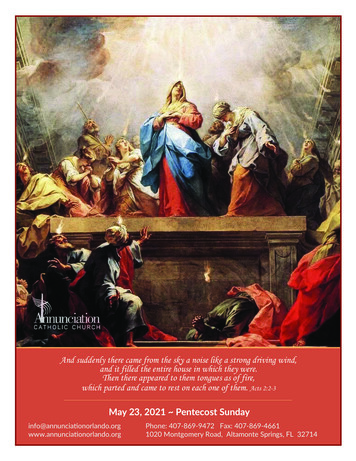
Transcription
The Artof Noise(futurist manifesto, 1913)by Luigi Russolotranslated by Robert Filliou1967A Great Bear Pamphletubuclassics2004
THE ART OF NOISELUIGI RUSSOLOubuclassics2004
ubuclassicsThe Art of NoiseLuigi RussoloOriginally published in 1967 as a Great Bear Pamphlet by Something Else Press.ubuclassicswww.ubu.comSeries Editor: Michael Tencerubu.com3
The Art of Noise(translated from L’arte dei Rumori)My dear Balilla Pratellagreat futurist musician,On March 9, 1913, during our bloody victory over four thousand passé-istsin the Costanzi Theater of Rome, we were fist-and-cane-fighting in defense of yourFuturist Music, performed by a powerful orchestra, when suddenly my intuitive mindconceived a new art that only your genius can create: the Art of Noises, logical con-sequence of your marvelous innovations. In antiquity, life was nothing but silence.Noise was really not born before the 19th century, with the advent of machinery.Today noise reigns supreme over human sensibility. For several centuries, life went onsilently, or mutedly. The loudest noises were neither intense, nor prolonged nor var-ied. In fact, nature is normally silent, except for storms, hurricanes, avalanches, cas-cades and some exceptional telluric movements. This is why man was thoroughlyamazed by the first sounds he obtained out of a hole in reeds or a stretched string.44
the art of noiseluigi russolowith religious respect, and reserved for the priests, who thereby enriched their riteswith a new mystery. Thus was developed the conception of sound as something apart,different from and independent of life. The result of this was music, a fantastic worldubuclassicsPrimitive people attributed to sound a divine origin. It became surroundedsuperimposed upon reality, an inviolable and sacred world. This hieratic atmospherewas bound to slow down the progress of music, so the other arts forged ahead andbypassed it. The Greeks, with their musical theory mathematically determined byPythagoras, according to which only some consonant intervals were admitted, havelimited the domain of music until now and made almost impossible the harmony theywere unaware of. In the Middle Ages music did progress through the developmentand modifications of the Greek tetracord system. But people kept considering soundonly in its unfolding through time, a narrow conception so persistent that we still findit in the very complex polyphonies of the Flemish composers. The chord did not yetexist; the development of the different parts was not subordinated to the chord thatthese parts could produce together; the conception of these parts was not vertical, butmerely horizontal. The need for and the search for the simultaneous union of different sounds (that is to say of its complex, the chord), came gradually: the assonant com-mon chord was followed by chords enriched with some random dissonances, to endup with the persistent and complicated dissonances of contemporary music.First of all, musical art looked for the soft and limpid purity of sound. Thenit amalgamated different sounds, intent upon caressing the ear with suave harmonies.Nowadays musical art aims at the shrilliest, strangest and most dissonant amalgams ofsound. Thus we are approaching noise-sound. This revolution of music isparalleled by the increasing proliferation of machinery sharing in humanlabor. In the pounding atmosphere of great cities as well as in the formerly silent coun-tryside, machines create today such a large number of varied noises that pure sound,with its littleness and its monotony, now fails to arouse any emotion.plex polyphony and a greater variety of instrumental tones and coloring. It has triedto obtain the most complex succession of dissonant chords, thus preparing the ground55ubu.comTo excite our sensibility, music has developed into a search for a more com-
the art of noiseluigi russoloThis evolution toward noise-sound is only possible today. The ear of an eighteenthcentury man never could have withstood the discordant intensity of some of thechords produced by our orchestras (whose performers are three times as numerous);ubuclassicsfor Musical Noise.on the other hand our ears rejoice in it, for they are attuned to modern life, rich in allsorts of noises. But our ears far from being satisfied, keep asking for bigger acousticsensations. However, musical sound is too restricted in the variety and the quality ofits tones. The most complicated orchestra can be reduced to four or five categories ofinstruments with different sound tones: rubbed string instruments, pinched stringinstruments, metallic wind instruments, wooden wind instruments, and percussioninstruments. Music marks time in this small circle and vainly tries to create a new variety of tones. We must break at all cost from this restrictive circle of puresounds and conquer the infinite variety of noise-sounds.Each sound carries with it a nucleus of foreknown and foregone sensationspredisposing the auditor to boredom, in spite of all the efforts of innovating com-posers. All of us have liked and enjoyed the harmonies of the great masters. For years,Beethoven and Wagner have deliciously shaken our hearts. Now we are fed up withthem. This is why we get infinitely more pleasure imagining combinations of the sounds of trolleys, autos and other vehicles, and loudcrowds, than listening once more, for instance, to the heroic or pastoralsymphonies.It is hardly possible to consider the enormous mobilization of energy that amodern orchestra represents without concluding that the acoustic results are pitiful. Isthere any, thing more ridiculous in the world than twenty men slaving to increase theplaintive meeowing of violins? This plain talk will make all music maniacs jump intheir seats, which will stir up a bit the somnolent atmosphere of concert halls. Shallwe visit one of them together? Let’s go inside one of these hospitals for anemicsounds. See, the first bar is dripping with boredom stemming from familiarity, andwe sip from bar to bar two or three sorts of boredom and keep waiting for the extraor-66ubu.comgives you a foretaste of the boredom that will drip from the next bar. In this fashion
the art of noiseluigi russoloheartrending mixture composed of the monotony of the sensations and the stupidand religious swooning of the audience, drunk on experiencing for the thousandthtime, with almost Bhuddist patience, with elegant and fashionable ecstasy. POUAH!Let’s get out quickly, for I can’t repress much longer the intense desire to create a trueubuclassicsdinary sensation that will never materialize. Meanwhile we witness the brewing of amusical reality finally by distributing big loud slaps right and left, stepping and pushing over violins and pianos, bassoons and moaning organs! Let’s go out!Some will object that noise is necessarily unpleasant to the ear. The objectionis futile, and I don’t intend to refute it, to enumerate all the delicate noises that givepleasant sensations. To convince you of the surprising variety of noises, I will mentionthunder, wind, cascades, rivers, streams, leaves, a horse trotting away, the starts andjumps of a carriage on the pavement, the white solemn breathing of a city at night,all the noises made by feline and domestic animals and all those man’s mouth canmake without talking or singing.Let’s walk together through a great modern capital, with the ear more atten-tive than the eye, and we will vary the pleasures of our sensibilities by distinguishingamong the gurglings of water, air and gas inside metallic pipes, the rumblings and rattlings of engines breathing with obvious animal spirits, the rising and falling of pis-tons, the stridency of mechanical saws, the loud jumping of trolleys on their rails, thesnapping of whips, the whipping of flags. We will have fun imagining our orchestra-tion of department stores’ sliding doors, the hubbub of the crowds, the different roarsof railroad stations, iron foundries, textile mills, printing houses, power plants andsubways. And we must not forget the very new noises of Modern Warfare. The poetMarinetti, in a letter from the Bulgarian trenches of Ariadnople described to me asfollows, in his new futurist style, the orchestra of a great battle:1 2 3 4 5 seconds the siege canons gut the silence by a chord-Tamtoumb! Immediately echoes, echoes, echoes, all echoes-quick!center of these flattened TAMTOUMBS-width 50 square kilometers-leap 2 3 6 8 splinters-fisticuffs-headrammings-rapid fire77ubu.comtake-it-crumble it-spread it-infinite distance to hell. In the center,
the art of noiseluigi russolothis grave bass apparent slowness-scan the strange madmenvery young-very mad mad mad-very agitated altos of the battleFury anguish breathless ears My ears open nasals! beware!such joy is yours o my people to sense see ear scent drinkubuclassicsbatteries Violence, ferocity, regularity, pendulum game, fatality-everything everything everything taratatatatata the machine-guns shouting twisting under a thousand bites slaps traaktraakcudgellings whippings pic pac POUMTOUMB jugglingclowns’ jump in full sky height 200 meters it’s the gunshoot-ing Downwards guffaws of swamps laughter buffalos chariotsstings prancing of horses ammunition-wagons flue flac zangchaak chaak rearings pirouettes patatraak bespatterings manesneighings i i i i i i i medley tinklings three bulgarian batallionson the move crook- craak (double bar slowly) Choumi Maritzao Karvavena officers’ shouts copper plates knocking againsteach other pam ici (vite) pac over there BOUM-pam-pam-pamhere there there farther all around very high look-out god-damnit on the head chaak marvelous! flames flames flamesflames flames flamesflames crawl fromforts over there Choukri Pacha telephone orders to 27 fortsin turkish German hello Ibrahim! Rudolf hello! hello! actorsroles blowing-echoes odor-hay-mud-manure I can’t feel myfrozen feet stale odor rotting gongs flutes clarinets pipes everywhere up down birds twitter beatitude shade greenness cip-cip ip-zzip herds pastures dong-dong-dong-ding-bééé OrchestraMadmen keep hitting orchestra professors they bent beatenplaying playing playing Great fracas far from erasing drinktiny noises revomit them precise them out of their echoingmouth wide open diameter 1 kilometer Debris of echos in thistheater of laying rivers sitting villages standing mounts recog-rows loggias groundfloor boxes 2,000 shrapnels gesticulation88ubu.comnized in the audience Maritza Tungia Rodopes 1st and 2d
the art of noiseluigi russolotoumb clouds-gallery 2,000 grenades thundering applause Quickquick such enthusiasm pulling hair very black hairs ZANG-TOUMB-TOUMB war noises orchestra blown beneath a noteof silence hanging in full sky captive golden balloon controllingubuclassicsexplosion zang-toumb white handkerchiefs full of gold toumb-the fire.We want to score and regulate harmonically and rhythmicallythese most varied noises. Not that we want to destroy the movements and irregular vibrations (of tempo and intensity) of these noises! We wish simply to fix thedegree or pitch of the predominant vibration, as noise differs from other sound in itsirregular and confuse vibrations (in terms of tempo and intensity).Each noise possesses a pitch, at times even a chord dominatingover the whole of these irregular vibrations. The existence of this predomi-nant pitch offers us the technical means of scoring these noises, that is to say to giveto a noise a certain variety of pitches without losing the timbre that characterizes anddistinguishes it. Certain noises obtained through a rotating movement can give us acomplete ascending or descending scale through the speeding up or slowing down ofthe movement.Noise accompanies every manifestation of our life. Noise is familiar to us.Noise has the power to bring us back to life. On the other hand, sound, foreign to life,always a musical, outside thing, an occasional element, has come to strike our ears nomore than an overly familiar face does our eye. Noise, gushing confusely and irregularly out of life, is never totally revealed to us and it keeps in store innumerable sur-prises for our benefit. We feel certain that in selecting and coordinating all noises wewill enrich men with a voluptuousness they did not suspect.art of noises must not be limited to a mere imitative reproduction. Theart of noises will extract its main emotive power from the special acoustic pleasure that99ubu.comAlthough the characteristic of noise is to brutally bring us back to life, the
the art of noiseluigi russoloes for the futurist orchestra that we intend soon to realize mechanically:1roarsclapsnoises of falling waterdriving noisesubuclassicsthe inspired artist will obtain in combining noises. Here are the six categories of nois-2whistlessnoressnortsbellows34whispersshrill mblesgurgles5cracksjingles6percussive noises using animal and human voices:metal, wood, skin,stone, baked earth, etc.shouts, moans, screams,laughter, rattlings, sobsWe have included in these 6 categories the most characteristic fundamental noises: theothers are hardly more than combinations of them. The rhythmic movements of anoise are infinite. There exists not only a predominant pitch, but as well a predom-inant rhythm around which more secondary rhythms are equally perceptible.ubu.com1010
the art of noiseluigi russolo1 - We must enlarge and enrich more and more the domain of musical sounds.ubuclassicsConclusions:Our sensibility requires it. In fact it can be noticed that all contemporary composers ofgenius tend to stress the most complex dissonances. Moving away from pure sound, theynearly reach noise-sound. This need and this tendency can be totally realized only throughthe joining and substituting of noises to and for musical sounds.2 - We must replace the limited variety of timbres of orchestral instruments by theinfinite variety of timbres of noises obtained through special mecha
musical reality finally by distributing big loud slaps right and left, stepping and push- ing over violins and pianos, bassoons and moaning organs! Let’s go out!











